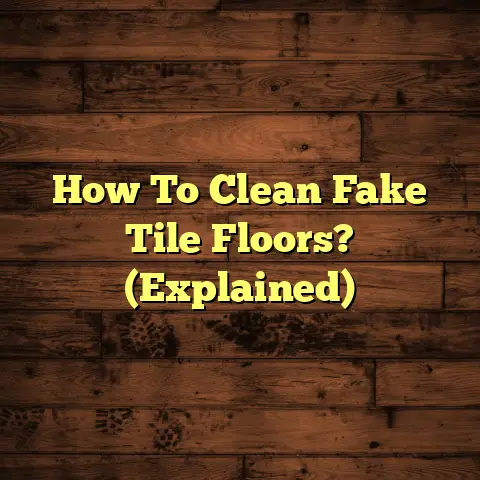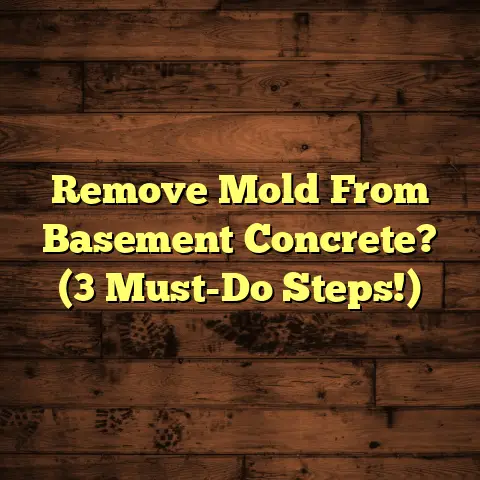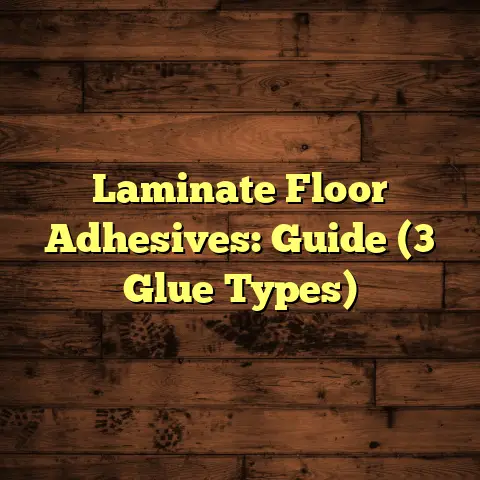Luxury Laminate Flooring Cost (Explained)
Luxury laminate flooring has surged in popularity among homeowners and commercial property managers alike. With its appealing aesthetics, durability, and cost-effectiveness, it’s not hard to see why. However, understanding the costs associated with installing luxury laminate flooring is crucial for making informed decisions. This guide will delve into the various factors impacting costs, detailed price breakdowns, comparisons with alternative flooring options, and actionable insights to help you navigate your flooring project successfully.
Major Cost Factors Affecting Luxury Laminate Flooring
When estimating the cost of luxury laminate flooring installation, several key factors come into play. Understanding these factors will help you make an informed decision when planning your flooring project.
Area Size
The total square footage of the area where the flooring will be installed is one of the primary cost determinants. Larger spaces will naturally incur higher material costs and may also affect labor costs due to the increased time required for installation.
For example, if you’re looking to install laminate flooring in a 100 sq ft room versus a 1,000 sq ft open-plan living area, the cost will significantly differ. Additionally, if your house has unique architectural features, such as arches or built-in shelving, these can affect the amount of flooring needed and the complexity of the installation.
Material Type and Quality
Luxury laminate flooring comes in various styles, qualities, and finishes. Higher-quality laminate, often referred to as high-density fiberboard (HDF), typically costs more but offers better durability and visual appeal.
AC Rating: One way to gauge laminate quality is through its AC rating, which measures surface durability. The higher the rating (ranging from AC1 to AC5), the more resistant the laminate is to scratches, impacts, and stains. For instance:
- AC1: Suitable for low-traffic residential areas.
- AC2: Better for moderate traffic.
- AC3: Good for residential and light commercial use.
- AC4: Ideal for commercial settings with moderate traffic.
- AC5: Designed for heavy commercial settings.
Choosing a higher AC rating may increase initial costs but can save you money in repairs or replacements in the long run.
Labor Costs
Labor costs can vary significantly based on geographical location, experience level of the installers, and the complexity of the installation. In metropolitan areas, you might find that skilled labor commands a premium rate.
For instance, hiring a contractor in Dhaka may cost more than hiring someone in a smaller city due to demand and competition. It’s essential to factor in labor costs when budgeting for your project, as this can significantly impact your overall expenses.
Additional Considerations
Several additional factors can impact the overall cost:
- Floor Removal: If you need to remove existing flooring—be it carpet, tile, or old laminate—this will add to your overall expenses. The removal process can vary in complexity and time required depending on what type of flooring you’re taking out.
- Subfloor Replacement: In cases where the subfloor is damaged or unsuitable for installation, replacement costs must be factored in. A sound subfloor is crucial for the longevity of your laminate flooring.
- Material Grade: The grade of the laminate can influence cost substantially. Higher-grade laminates often come with better warranties and longer lifespans.
- Room Size/Layout: Oddly shaped rooms or those requiring extensive cutting may increase labor time and material waste, thus raising costs.
- Installation Type: Costs can vary based on whether you opt for glue-down, click-lock, or staple-down installation methods. Click-lock systems tend to be easier and faster to install compared to glue-down options but may come at a higher price.
Detailed Cost Breakdown and Price Ranges
Price Range for Luxury Laminate Flooring
On average, luxury laminate flooring costs between $1 to $5 per square foot for materials alone. Here’s a detailed breakdown based on project size and quality:
| Project Size (sq ft) | Low-End Cost | High-End Cost |
|---|---|---|
| 100 | $100 | $500 |
| 500 | $500 | $2,500 |
| 1,000 | $1,000 | $5,000 |
Note: These estimates are for materials only and do not include labor or additional costs.
Cost of Labor
Labor typically ranges from $2 to $6 per square foot. Therefore, for a 1,000 sq ft area, you might expect to pay:
- Low-End Labor Cost: $2,000 (1000 sq ft x $2)
- High-End Labor Cost: $6,000 (1000 sq ft x $6)
Total Estimated Costs
Combining material and labor costs provides a clearer picture of total expenses:
| Project Size (sq ft) | Total Low-End Cost | Total High-End Cost |
|---|---|---|
| 100 | $200 | $600 |
| 500 | $1,000 | $8,500 |
| 1,000 | $3,000 | $11,000 |
Additional Expenses
Other potential expenses include:
- Underlayment: Depending on your subfloor condition and soundproofing needs, an underlayment may cost between $0.50 to $1.00 per square foot.
- Transition Strips: Transition strips between different flooring types or doorways generally cost between $2 to $5 each.
- Baseboards/Trim: Replacing or adding baseboards can add another $1 to $5 per linear foot.
Comparing Costs: Hardwood vs Alternative Flooring Options
When considering flooring options, it’s essential to compare luxury laminate with hardwood and other alternatives:
Hardwood Flooring
- Cost: Typically ranges from $5 to $15 per square foot for materials alone.
- Durability: More durable but can be susceptible to scratches and moisture damage. Regular maintenance is crucial.
- Lifespan: Can last decades if properly maintained.
Vinyl Flooring
- Cost: Usually ranges from $1 to $4 per square foot.
- Durability: Highly resistant to moisture and scratches; ideal for high-traffic areas.
- Lifespan: Lasts about 10–20 years depending on quality.
Carpet
- Cost: Typically ranges from $2 to $7 per square foot.
- Durability: Soft underfoot but can wear out quickly; requires more maintenance.
- Lifespan: Generally lasts 5–15 years.
Signs Your Hardwood Floors Need Replacement
While this article focuses on luxury laminate flooring, it’s important to note when hardwood floors may require replacement:
1. Severe Scratching or Gouging
If your hardwood floors have deep scratches or gouges that cannot be sanded away during refinishing, it may be time for replacement.
2. Warping or Buckling
Excessive moisture or improper installation can lead to warping or buckling. If significant areas are affected, replacement might be necessary.
3. Excessive Cupping
Cupping occurs when the edges of the boards are higher than the centre due to moisture imbalances. This often indicates an underlying issue that may require replacement rather than refinishing.
4. Persistent Odors
If you notice unpleasant smells emanating from your hardwood floors (often due to trapped moisture), this could signal mold or mildew growth—issues that might necessitate replacement.
In such cases, consider whether refinishing the hardwood is a viable option or whether complete replacement might be more cost-effective.
Pros and Cons of Luxury Laminate Flooring
Luxury laminate flooring offers several advantages as well as some drawbacks that should be considered before making a final decision.
Pros
- Cost-Effective: Generally cheaper than hardwood while mimicking its appearance.
- Durability: Resistant to scratches and fading; easy to maintain compared to hardwood.
- Variety: Available in numerous styles and finishes that can suit any decor.
- Ease of Installation: Many products feature click-lock systems that allow for easier installation without glue or nails.
- Eco-Friendly Options: Some manufacturers offer eco-friendly laminate made from recycled materials.
Cons
- Less Authenticity: Doesn’t offer the same warmth or uniqueness as real wood; may not have the same resale value.
- Moisture Sensitivity: While more resistant than hardwood, prolonged exposure can lead to damage if not properly maintained.
- Sound Quality: Laminate can be noisier than hardwood; underlayment can help mitigate this but may add to costs.
- Limited Refinishing Options: Unlike hardwood, which can often be sanded down and refinished multiple times, laminate cannot be refinished once it has worn down.
- Heat Sensitivity: Extreme heat can cause laminate flooring to warp or buckle if not installed with proper expansion gaps.
Professional Installation vs DIY
When deciding whether to hire professionals or take on a DIY project for luxury laminate flooring installation, it’s essential to weigh both costs and benefits carefully.
Cost Differences
- Professional Installation: Total costs could range from $3 to $11 per square foot (including materials and labor). Hiring a professional may save time but could lead to higher overall expenses.
- DIY Installation: While you save on labor costs by doing it yourself (typically only paying for materials), remember that tools and materials can still add up.
Tools & Skills Required
Investing in tools such as a miter saw, laminate cutter, tapping block, and spacers is essential for a successful DIY project. Moreover, skills such as measuring accurately and understanding floor layout are crucial.
Some basic tools you may need include:
- Measuring Tape
- Square
- Level
- Utility Knife
- Pull Bar
- Rubber Mallet
If you lack experience in home improvement projects or feel uncomfortable using power tools, it may be wise to hire a professional installer instead.
Questions to Ask Hardwood Flooring Contractors
Before hiring a contractor for luxury laminate flooring installation, consider asking the following questions:
- How many years of experience do you have in installing laminate flooring?
- Can you provide references from previous clients?
- What type of warranty do you offer for both materials and workmanship?
- How do you handle unexpected issues during installation?
- What preparations should I make before installation day?
- Can you provide a detailed estimate that includes all potential costs?
- How do you plan on managing dust and debris during installation?
- Do you offer eco-friendly installation options?
- What types of underlayment do you recommend?
- How long do you anticipate the installation process will take?
Asking these questions will give you valuable insight into their professionalism and expertise while helping ensure a smooth installation process.
Hardwood Floor Care and Maintenance Tips
To maximize the longevity of your luxury laminate flooring:
1. Regular Cleaning
Sweep or vacuum regularly to remove debris that could scratch the surface. Use a microfiber mop or cloth dampened with water and a cleaner specifically designed for laminate surfaces.
2. Use Proper Cleaners
Avoid harsh chemicals; use products designed for laminate floors that are gentle yet effective at cleaning without damaging the surface.
3. Humidity Control
Maintain consistent humidity levels (between 30% – 50%) in your home to prevent warping or buckling caused by extreme dryness or dampness.
4. Area Rugs
Use rugs in high-footfall areas such as entryways or living rooms to protect against wear and tear while adding style and comfort.
5. Furniture Pads
Place felt pads under furniture legs to prevent scratches when moving items around your space.
6. Avoid Excessive Water
Limit water exposure; avoid wet mopping as excess moisture can seep into seams causing damage over time.
Conclusion
Understanding the costs associated with luxury laminate flooring is crucial in making informed decisions for your home or business renovation projects. By considering various factors such as area size, material quality, labor costs, additional considerations like floor removal or subfloor replacement, you can develop a comprehensive budget that aligns with your needs.
Whether opting for professional installation or taking on a DIY project, being equipped with the right knowledge will enable you to navigate this process smoothly from start to finish while ensuring your new floors enhance your space beautifully for years ahead.
Investing in luxury laminate flooring not only adds value to your property but also elevates your living environment with style and functionality—truly worth every penny spent!





